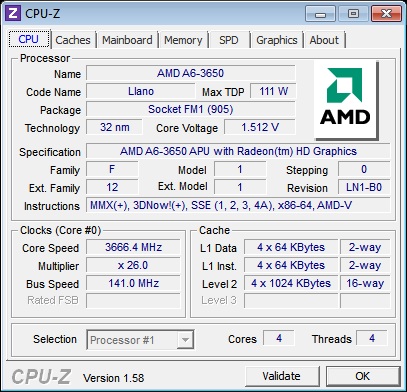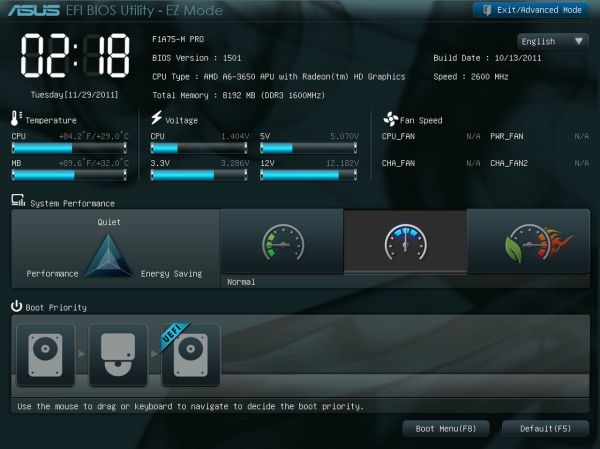ASUS F1A75-M Pro Review - Micro-ATX Llano at $110
by Brendan van Varik on January 22, 2012 2:00 AM EST- Posted in
- Motherboards
- Asus
- Llano
BIOS
As with previous ASUS A75 iterations, our BIOS today is a fully graphical based BIOS - I found it easy to navigate around and find what you are looking for. All of the settings are where you would expect to find them and I feel that ASUS engineers have made this BIOS with ease of use in mind.
The front page of the BIOS contains the basic information of the system along with some voltage readings and temperatures. You can change the boot order here as well by dragging the device which you would like the board to boot from to the front of the list. The three system performance options offer power saving (green), normal (blue), or mildly TPU overclocked (red).
The overclocking section of the BIOS has plenty of settings for you to play around with, including multiplier (with locked APUs only being able to reduce the multiplier), base frequencies, memory strap and voltages either by offset or absolute values. The OC Tuner option does the equivalent of enabling the TPU - under Ai Overclock Tuner, we have some predefined settings for users to enable, assuming their hardware is capable.
Under the monitoring section, you will be able to control three of the four fans, namely the CPU fan and two chassis fans. The fourth fan is a power fan which is not controllable and will always run at full speed.
If you wish to update the BIOS, it is easily done with a USB stick which is formatted to a FAT file system. I was unable to discern noticeable changes between the 1501 BIOS which was used during the review compared to the newest revision (at the time of writing).
Overclocking
If you decide to overclock your system with the automated process in either the BIOS or the software which ASUS provide, the 'OC Tuner', I only got an extra 3 MHz put on to the bus speed, which equates to 78 MHz on the clock speed of the A6-3650 APU (26x100). The voltages remain at stock and the system is stable. The RAM is automatically bumped up to the 1866MHz strap with the correct timings and voltages set which are in the X.M.P profile. Due to the bus being overclocked by 3 MHz, the RAM ends up with a final speed of 1922 MHz with the same timings and 1.65 volts is applied.

When I overclocked the system manually via the BIOS, I was able to achieve a final base clock of 141 MHz at 1.5 V, which gave an overall clock speed of 3666.4 MHz.



















32 Comments
View All Comments
amxn - Sunday, January 22, 2012 - link
I don't know if the tables are wrong or if Asus are actually expecting people to pay more for a product that loses quite a few features than its lower priced variant?just4U - Sunday, January 22, 2012 - link
Well it's mini-itx so that's likely the reason why the deluxe version is more expensive.StevoLincolnite - Sunday, January 22, 2012 - link
That's Micro-ATX.Mini-ITX only has the one PCI/PCI-E slot.
Death666Angel - Sunday, January 22, 2012 - link
What? The Deluxe version is mini-ITX and costs more (and pretty much all mITX boards I know come with PCIe x4-x16 depending on CPU/chipset). The tested version in this article is micro-ATX and has 1 PCIe x16, 1 PCIe x1, 1 PCIe x4 and 1 PCI slot. So I'm not sure what your comment is referring to. :-)chui101 - Sunday, January 22, 2012 - link
I didn't realize CPU temperatures could be measured in FPS too! ;)Great review, thanks! I'm really tempted to build a mini ITX Llano system... this might be the board I go with!
BLaber - Sunday, January 22, 2012 - link
Please mention power supply used on Power consumption test page to help make sense of power consumption test numbers.bobbozzo - Sunday, January 22, 2012 - link
Also, I would like to see power consumption without any added video cards.thanks
Dobs - Sunday, January 22, 2012 - link
Totally agree !!! Prolly a 1000W monster PSU like last time."These are the real world values that consumers may expect from a typical system" ummmmmmm whose real world?
Why does it seem sooo hard for Anandtech to give decent psu and power consumption info on anything related to Llano? Seriously
fic2 - Monday, January 23, 2012 - link
Have to agree. This would probably make a good HTPC, but who would put dual 5850s in an HTPC. Seems like bizarro test setup to measure the power consumption of a motherboard. Like measuring the mpg of a car when it is pulling a horse trailer and calling it "typical".Kevin G - Sunday, January 22, 2012 - link
I'm curious how far this board can take the unlocked A8-3870K when overclocked.